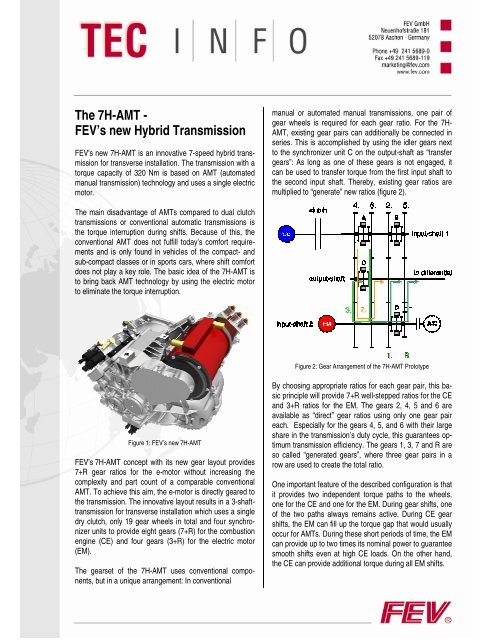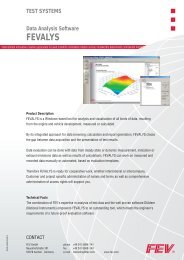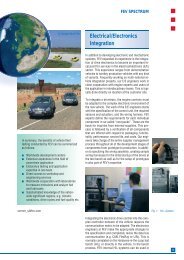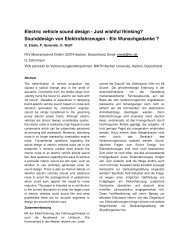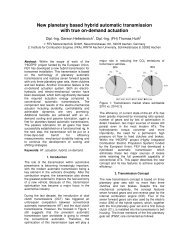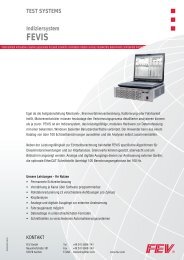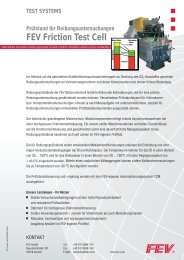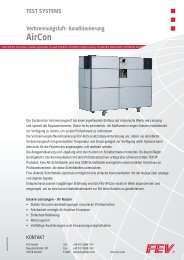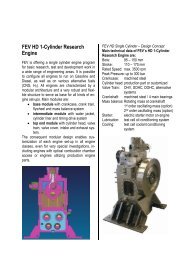The 7H-AMT - FEV's new Hybrid Transmission
The 7H-AMT - FEV's new Hybrid Transmission
The 7H-AMT - FEV's new Hybrid Transmission
You also want an ePaper? Increase the reach of your titles
YUMPU automatically turns print PDFs into web optimized ePapers that Google loves.
<strong>The</strong> <strong>7H</strong>-<strong>AMT</strong> -<br />
FEV’s <strong>new</strong> <strong>Hybrid</strong> <strong>Transmission</strong><br />
<strong>FEV's</strong> <strong>new</strong> <strong>7H</strong>-<strong>AMT</strong> is an innovative 7-speed hybrid transmission<br />
for transverse installation. <strong>The</strong> transmission with a<br />
torque capacity of 320 Nm is based on <strong>AMT</strong> (automated<br />
manual transmission) technology and uses a single electric<br />
motor.<br />
<strong>The</strong> main disadvantage of <strong>AMT</strong>s compared to dual clutch<br />
transmissions or conventional automatic transmissions is<br />
the torque interruption during shifts. Because of this, the<br />
conventional <strong>AMT</strong> does not fulfill today’s comfort requirements<br />
and is only found in vehicles of the compact- and<br />
sub-compact classes or in sports cars, where shift comfort<br />
does not play a key role. <strong>The</strong> basic idea of the <strong>7H</strong>-<strong>AMT</strong> is<br />
to bring back <strong>AMT</strong> technology by using the electric motor<br />
to eliminate the torque interruption.<br />
Figure 1: FEV’s <strong>new</strong> <strong>7H</strong>-<strong>AMT</strong><br />
FEV’s <strong>7H</strong>-<strong>AMT</strong> concept with its <strong>new</strong> gear layout provides<br />
7+R gear ratios for the e-motor without increasing the<br />
complexity and part count of a comparable conventional<br />
<strong>AMT</strong>. To achieve this aim, the e-motor is directly geared to<br />
the transmission. <strong>The</strong> innovative layout results in a 3-shafttransmission<br />
for transverse installation which uses a single<br />
dry clutch, only 19 gear wheels in total and four synchronizer<br />
units to provide eight gears (7+R) for the combustion<br />
engine (CE) and four gears (3+R) for the electric motor<br />
(EM).<br />
<strong>The</strong> gearset of the <strong>7H</strong>-<strong>AMT</strong> uses conventional components,<br />
but in a unique arrangement: In conventional<br />
manual or automated manual transmissions, one pair of<br />
gear wheels is required for each gear ratio. For the <strong>7H</strong>-<br />
<strong>AMT</strong>, existing gear pairs can additionally be connected in<br />
series. This is accomplished by using the idler gears next<br />
to the synchronizer unit C on the output-shaft as “transfer<br />
gears”: As long as one of these gears is not engaged, it<br />
can be used to transfer torque from the first input shaft to<br />
the second input shaft. <strong>The</strong>reby, existing gear ratios are<br />
multiplied to “generate” <strong>new</strong> ratios (figure 2).<br />
Figure 2: Gear Arrangement of the <strong>7H</strong>-<strong>AMT</strong> Prototype<br />
By choosing appropriate ratios for each gear pair, this basic<br />
principle will provide 7+R well-stepped ratios for the CE<br />
and 3+R ratios for the EM. <strong>The</strong> gears 2, 4, 5 and 6 are<br />
available as “direct” gear ratios using only one gear pair<br />
each. Especially for the gears 4, 5, and 6 with their large<br />
share in the transmission’s duty cycle, this guarantees optimum<br />
transmission efficiency. <strong>The</strong> gears 1, 3, 7 and R are<br />
so called “generated gears”, where three gear pairs in a<br />
row are used to create the total ratio.<br />
One important feature of the described configuration is that<br />
it provides two independent torque paths to the wheels,<br />
one for the CE and one for the EM. During gear shifts, one<br />
of the two paths always remains active. During CE gear<br />
shifts, the EM can fill up the torque gap that would usually<br />
occur for <strong>AMT</strong>s. During these short periods of time, the EM<br />
can provide up to two times its nominal power to guarantee<br />
smooth shifts even at high CE loads. On the other hand,<br />
the CE can provide additional torque during all EM shifts.
Figure 3: Simulation of Vehicle Launch<br />
<strong>The</strong> <strong>7H</strong>-<strong>AMT</strong> features all standard operating modes of a<br />
full hybrid transmission, including start/stop and boosting/regeneration<br />
in all gears. All-electric driving is performed<br />
in first EM gear, which can be used up to a speed<br />
of around 70 km/h. This ensures that all inner city driving<br />
situations can be covered by the all-electric driving mode if<br />
desired. As soon as the driver requests more torque than<br />
can be delivered by the EM alone, the combustion engine<br />
is started by controlled slip of the clutch and precise modulation<br />
of EM torque. For this restart, several different gear<br />
ratios are available, including CE 1st, 2nd and 5th. By using<br />
5th gear, the CE can be restarted at moderate rpm and<br />
thus low noise levels. For situations where maximum acceleration<br />
is requested, restart can be performed in 2nd or<br />
even 1st CE gear.<br />
As an additional feature, the EM can be used to drive an<br />
A/C compressor, e.g. during start/stop phases. <strong>The</strong> compressor<br />
is mounted in front of the transmission and connected<br />
to the second input shaft and thus to the EM using<br />
a conventional magnetic clutch and belt drive. During standard<br />
driving, the compressor is mechanically driven by the<br />
second input shaft. <strong>The</strong>reby, efficiency is increased compared<br />
to electric compressors. Also, weight and costs are<br />
reduced because no additional electric motor is required<br />
for the A/C compressor.<br />
With 356 mm, the installation length of the <strong>7H</strong>-<strong>AMT</strong> prototype<br />
is comparable to that of state-of-the-art 6-speed manual<br />
transmissions in the same torque range.<br />
Table 1: <strong>Transmission</strong> Main Data<br />
Torque Capacity 320 Nm (CE) + 70 Nm (EM)<br />
Total Centre Distance 196.94 mm<br />
Gear Ratio Spread 6.77 (CE) / 5.29 (EM)<br />
Weight (dry) 59 kg (w/o DMF, EM and ACC)<br />
Installation Length 356 mm<br />
Shifter System On-demand electro-hydraulic<br />
Synchronizer Units A/B Dual Cone Carbon<br />
Synchronizer Units C/D Single Cone Carbon<br />
CE – combustion engine, EM – electric motor<br />
DMF – dual mass flywheel, ACC - air-conditioning compressor<br />
Key features of the <strong>7H</strong>-<strong>AMT</strong> prototype:<br />
� Advanced 7-speed hybrid <strong>AMT</strong><br />
� Single electric motor<br />
� Full hybrid functionality including E-drive<br />
� No torque interruption during gear shifts<br />
� Ultra compact design for transverse installation<br />
� Best efficiency, low complexity<br />
Figure 4: <strong>7H</strong>-<strong>AMT</strong> Prototype on Test Bench<br />
Contacts: Dipl.-Ing. Volker Rosenburg<br />
FEV GmbH<br />
E-Mail: rosenburg@fev.com<br />
Dipl.-Ing. Gereon Hellenbroich<br />
Institute for Combustion Engines<br />
RWTH Aachen University<br />
E-Mail: hellenbroich@vka.rwth-aachen.de<br />
Status: 24.09.2009


